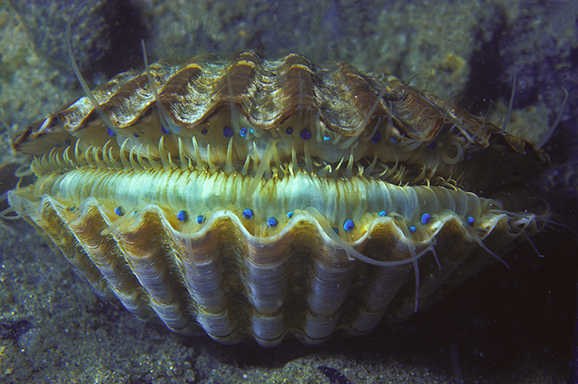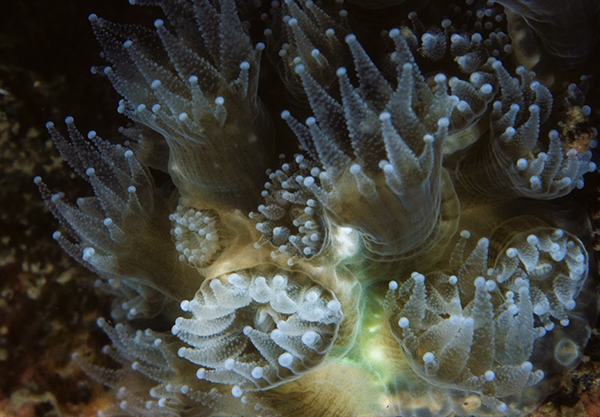Donning scuba gear, you don’t have to descend very far below the surface of Long Island Sound to discover some of its prettiest marine animals. In less than 20 feet, you can encounter large flower-like clusters of pink-hearted hydroids, swaying slowly back and forth in the current. Attached to rocks, shipwrecks or other hard surfaces by their long stems, the hydroids are armed with stinging cells like their close relatives, the corals, anemones, and jellyfish. Unlike jellyfish, however, their stinging cells can’t penetrate human skin. Their cells serve to incapacitate their prey – microscopic size plankton such as copepods.
As you take the time to check out the pink-hearted hydroids, you might also spot the colorful red-gilled nudibranch, a shell-less snail that grazes on the hydroids. The one-inch long nudibranch is misnamed. The white-tipped, red projections rising from its back are not gills; they are part of its gut. As the creature feeds on the hydroids, it stores its prey’s stinging cells in its gut extensions. Should a predator then try to dine on the nudibranch, it might encounter a nasty sting.

During the retreat of ice-age glaciers, huge boulders, like the one standing on the shore at Crane Neck Point (Smithtown Bay), were left behind some 20,000 years ago. Similar size rocks, scattered through Long Island Sound, are habitat for many other beautiful marine animals. Off Horton Point, a huge underwater boulder was host to a carpet of white anemones. Barely 1 1/2 inches high and a 1/2 inch wide, their mouth is surrounded by long tentacles. They capture their prey, small fish and plankton, with thin white threads of stinging cells. The anemones can shift position for short distances by lifting and spreading their base, marching along like an inchworm.
The delicate, 2-inch tall lined anemones can be found nearly covering some of the rocks in the shallows of Anchor Beach, Milford, CT. Our largest and very common frilled anemone can be found throughout the Sound, attached to rocks, pilings, and wrecks. Topped by up to 1,000 white tentacles, its body varies in color from brown to yellow. It feeds on small fish and plankton.

Dock pilings are also great sites to find colorful sea squirts (tunicates) and a couple of our feather duster (tube) worms. Though tiny in comparison to those found in tropical waters, on close-up, the tube worms are truly eye-catching. The Sound’s star tunicate, an introduced species, is also well worth looking for. A close-up image of these marine animals can be astonishing!
To the surprise of some, the Sound is host to a non-reef building stoney coral, the northern star coral. The fuzzy, yellow-brown coral colony can be no larger than a silver dollar. Attached to rocks, pilings or other hard surfaces, it is frequently found in very shallow water to a depth of over 130 feet. The knobs at the tip of its tentacles house harpoon-like stinging cells that are injected into its prey. Once a victim is stunned, it is directed by the tentacles to the coral’s mouth. A yellow, cream-colored soft coral, photographed off the north-east end of Fishers Island, at a depth of 80+ feet, is called dead man’s finger. Though never spotted by this diver in the Sound, it may also inhabit deep-water rocks at the Race, between the SW side of Fishers Island and Little Gull Island (dive it at slack tide!). It is also found at Fort Wetherill, Rhode Island, at a depth of less than 30 feet.
The Sound is home to an intriguing variety of mollusks — snails and bivalves (clam-like). By far, the Atlantic scallop, with its 30 to 40 arresting, steel-blue eyes, tops them all. It can identify an approaching hungry sea star by detecting chemicals produced by the predator. Tentacles that protrude from the edge of its shell are also sensitive to a predator’s touch and its eyes, equipped with a cornea, lens, retina and optic nerve, detect shadows (but no images). As a shadow moves from one eye to the next, the alerted scallop can escape by swimming off erratically, jet propelled.
The scallops live on near-shore mud shallows and eelgrass beds in waters less than 15 feet at low tide. The seagrass beds in the Sound are found only eastward of Clinton Harbor (CT). They are habitat for a variety of nursery fishes and other marine life including adult and juvenile scallops. The beds were once found throughout the Sound but following a fungal disease during the 1930s, all of the beds were nearly wiped out.
In very shallow water, ranging in less than 1 to 3 feet, you can occasionally spot the solar-powered, shell-less snail, the Eastern emerald elysia. Its usual habitats include salt marshes, tidal creeks and tide pools –difficult to navigate with scuba gear! Generally, less than 2 inches long, the beautiful green creature feeds exclusively on a seaweed called vaucheria. As it grazes, elysia take in some of the seaweed’s sunlight-capturing cells that it uses for itself to get energy from the sun. Though it can be found along the entire coast, from Nova Scotia to south Florida, the stunning little creature seems to only inhabit the eastern end of Long Island Sound.
Long Island Sound is a great ecosystem that provides a nursery and residence for many other beautiful marine animals. For further exploration of the Sound’s many creatures, go to seasportsimages.com and click on the YouTube links.
